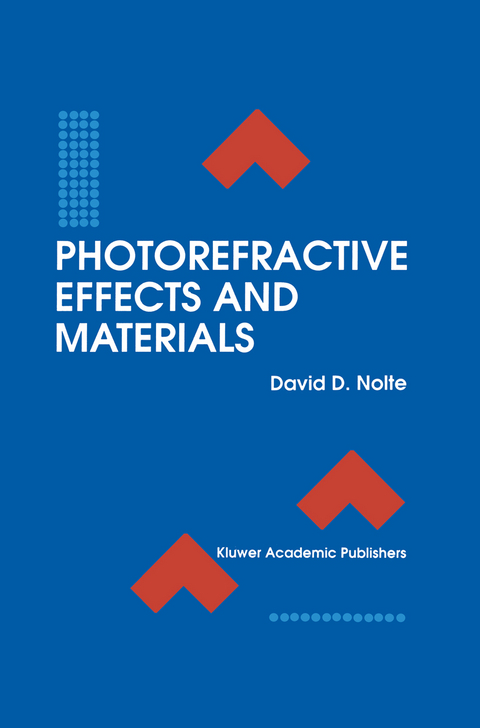
Photorefractive Effects and Materials
Springer (Verlag)
978-0-7923-9560-7 (ISBN)
1 Photorefractive Transport and Multi-Wave Mixing.- 1. The Photorefractive Effect.- 2. Coherent Interference.- 3. Defect Photoionization and Carrier Trapping.- 4. One-Dimensional Transport Equations and Space-Charge Gratings.- 5. Electro-Optics.- 6. Wave Propagation in Periodic Dielectric Media.- 7. Photorefractive Two-Wave Mixing.- 8. Photorefractive Four-Wave Mixing.- References.- 2 The Photorefractive Effect in Ferroelectric Oxides.- 1. Introduction.- 2. BaTiO3.- 3. Cobalt and Rhodium Doping of BaTiO3.- 4. Defect Chemistry.- 5. Reduction of BaTiO3.- 6. Electron Paramagnetic Resonance in Transition-Metal-Doped BaTiO3.- 7. Spark Source Mass Spectroscopy.- 8. X-Ray Topography.- 9. Effective Electro-Optic Coefficients.- 10. Deep and Shallow Trap Photorefractive Model.- 11. Beam Coupling Measurement Technique.- 12. Characterization of BaTiO3:Co.- 13. Characterization of BaTiO3:Rh.- 14. Optimizing the Photorefractive Sensitivity.- 15. Conclusions.- References.- 3 Permanently Fixed Volume Phase Gratings in Ferroelectrics.- 1. Introduction.- 2. Material Properties of Common Ferroelectrics.- 3. Photoferroelectric Phenomena.- 4. Electro-Optic Effect.- 5. Ferroelectric Domain Structure.- 6. Phenomenology of Fixing.- 7. Thermally Assisted Ionic Drift.- 8. Fixing by Ferroelectric Polarization Reversal.- 9. Applications of Ferroelectric Domain Gratings.- 10. Conclusion.- References.- 4 Photorefractive Spatial Solitons.- 1. Introduction.- 2. Beam Propagation in Photorefractive Media.- 3. The Photorefractive Soliton Equation.- 4. Design Considerations.- 5. Experimental Observation of Bright Solitons.- 6. Planar Dark Solitons and Vortex Solitons.- 7. Stability of Photorefractive Solitons.- 8. Discussion.- References.- 5 Photorefractive Polymers.- 1. Introduction.- 2. Special Properties of Organic Photorefractive Polymers.- 3. Materials Classes.- 4. Theoretical Issues for Photorefractive Polymers.- 5. Applications for Photorefractive Polymers.- References.- 6 Near-Resonant Photorefractive Effects in Bulk Semiconductors.- 1. Introduction to Photorefractive Semiconductors.- 2. Beam Coupling Gain Enhancement Techniques.- 3. Photorefractive Response at High Modulation Depths.- 4. Semiconductors as Self-Pumped Phase Conjugate Mirrors.- 5. Summary.- References.- 7 Photorefractive Quantum Wells and Thin Films.- 1. Introduction.- 2. Diffraction from Thin Films.- 3. Semiconductor Quantum Wells and Thin Films.- 4. Exciton Electro-Optics.- 5. Defect Engineering and Semi-Insulating Material.- 6. Transverse-Field Geometry.- 7. Longitudinal-Field Transmission Geometry.- 8. Applications.- References.- 8 Photorefractive Fibers.- 1. Introduction.- 2. General Theory.- 3. Four-wave Mixing in Optical Fibers Using Multi-mode Pump Beams.- 4. Phase Conjugation with one External Pump Beam.- 5. Photorefractive Issues Specific to Fibers.- 6. Applications.- References.
| Reihe/Serie | Electronic Materials: Science & Technology |
|---|---|
| Zusatzinfo | 27 Illustrations, black and white; X, 489 p. 27 illus. |
| Verlagsort | Dordrecht |
| Sprache | englisch |
| Maße | 155 x 235 mm |
| Themenwelt | Technik ► Elektrotechnik / Energietechnik |
| Technik ► Maschinenbau | |
| ISBN-10 | 0-7923-9560-3 / 0792395603 |
| ISBN-13 | 978-0-7923-9560-7 / 9780792395607 |
| Zustand | Neuware |
| Haben Sie eine Frage zum Produkt? |
aus dem Bereich


